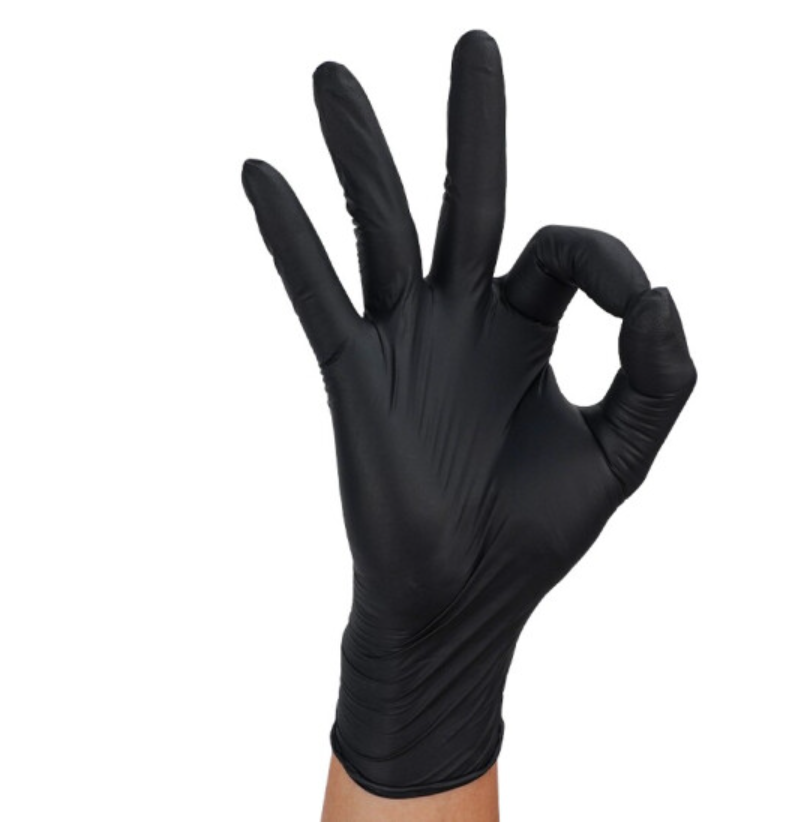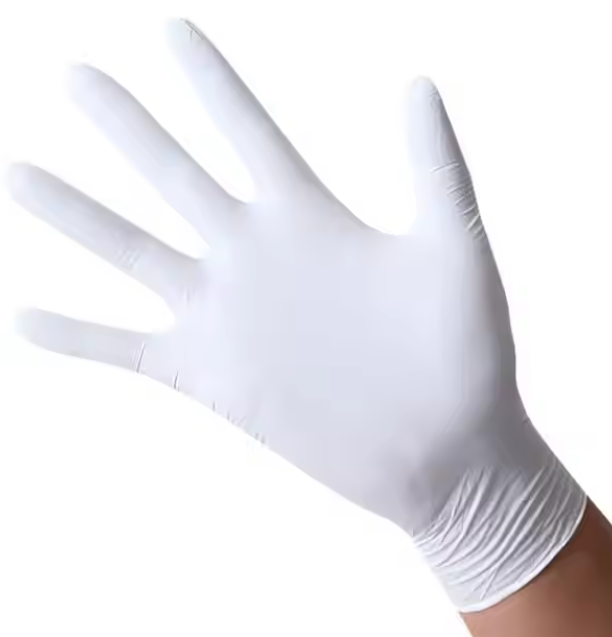1. Origin of Latex
Latex gloves are a specialized type of protective glove made from natural latex rubber. Unlike conventional gloves, they are widely used across various industries such as household cleaning, healthcare, industrial production, and beauty services. Made from high-quality natural rubber latex and refined with precise additives, latex gloves undergo special surface treatments to ensure comfort during wear. They are essential hand protection products in agriculture, industry, medical care, and daily life.
2. Latex Manufacturing Process
The raw rubber is first cut into slices using a rubber mixing machine, then dissolved with gasoline in a solution tank. This rubber solution is emulsified and adjusted before being pumped into a latex intermediate tank. The dissolved rubber solution is transferred to the top of a distillation tower, where steam heating vaporizes the lighter gasoline components. The gasoline vapor is cooled by mixing with cold water, and the oil-water mixture is separated. The recovered gasoline is reused, while the water is cooled and recirculated to condense vapors in the distillation tower.
The processed latex is then transferred to a stirring tank and blended before being centrifuged to extract the glove-grade latex material. After coloring and filtration, it is ready for glove production.
Hand mold forms are first cleaned with acid and alkali, rinsed with water, and preheated in hot water. They are then dipped in a coagulant solution and dried before immersion in latex. The molds undergo initial drying in an oven, receive an inner lining of fibers, are rinsed with hot water, and then vulcanized and fully dried in another oven.
After molding, gloves are inflated for inspection, shaped at low temperatures, dried at medium temperatures, washed, dehydrated, and finally dried again. The finished gloves are then packaged and sent to storage.
3. Pollution During Production and Treatment Measures
Pollution Sources:
1.Wastewater from mold washing and latex rinsing processes
2.Minor ammonia emissions during production
3.Dust from the drying process
4.Emissions of SO₂, NOx, and particulates from boiler operations
5.Emissions from backup diesel generators
6.Solid waste generated during production
7.Sludge from the wastewater treatment plant
Treatment Methods:
Water treatment involves physicochemical and biological contact oxidation processes, as well as activated carbon adsorption. The process includes mechanical screens, regulating tanks, air flotation tanks, contact oxidation tanks, sedimentation tanks, sand filtration units, activated carbon filters, and blower rooms. Exhaust gases are treated using a Venturi stone dust collector, followed by alkaline water scrubbing for desulfurization and dust removal.
4. Key Features of Latex Gloves
Latex gloves are ideal for use in automotive manufacturing, battery production, fiberglass fabrication, aircraft assembly, aerospace operations, and environmental cleanup. Their core features include:
•Excellent abrasion and puncture resistance
•Strong resistance to acids, oils, fuels, and many solvents
•Broad chemical protection with effective oil repellence
•FDA-compliant
•Unique fingertip textures for superior grip
•Patented palm-free design for uniform latex coating
•Ergonomic fit with cotton lining for added comfort
5. latex gloves Materials
Gloves can be made from various materials including cotton yarn, velvet, leather, and synthetic fibers. Key materials include:
•PVC lining – Heat-resistant design
•Dotting with plastic – Best anti-slip solution
•PU or latex coatings – Suitable for oily or greasy environments
latex gloves materials:
1.Metal Wire (e.g. stainless steel, chrome alloy) – Extremely cut-resistant but heavy
2.Synthetic Fibers (e.g. Kevlar, Spectra) – Lightweight and comfortable, with good cut resistance
3.Nitrile (with fabric lining) – Resistant to abrasion and punctures, flexible and comfortable
4.Natural Latex (with lining) – Highly elastic, soft, with some cut and tear resistance
5.PVC (with lining) – Good abrasion and puncture protection, limited tear resistance
6.Leather
•Cowhide: Comfortable, durable, breathable, heat-resistant
•Pigskin: Excellent breathability, remains soft after washing
•Sheepskin: Most comfortable and durable, excellent for tactile work, premium-priced
6. Powdered vs. Powder-Free Latex Gloves
Medical-grade sterile latex gloves are typically made from natural rubber and can degrade over time when exposed to oils or fats. Powdered gloves are easier to don and doff due to added cornstarch or talcum powder. However, these powders may bind to soluble latex proteins and cause allergic reactions in sensitive individuals.
Powder free latex gloves usually undergo a chlorination process, reducing the risk of allergies. Both types can be used for domestic tasks like dishwashing, but powder-free options are safer for those with latex sensitivity.
7. What Are Latex Gloves?
Latex gloves are
latex gloves disposable made from natural rubber latex. They are primarily used in the medical and food service industries to prevent cross-contamination and protect the hands from harsh chemicals. They are also widely used for cleaning and other tasks that require hand protection. Latex gloves are available in powdered and powder-free varieties and come in multiple sizes to ensure proper fit. They are regarded as medical-grade protective products.
8. How Are Latex Gloves Made?
Latex gloves are produced from natural rubber latex, a milky liquid extracted from rubber trees. The sap is collected by cutting into the tree bark, then processed to remove impurities. The manufacturing process involves dipping glove molds into a latex mixture, baking them to solidify the material, washing and powdering the gloves (if applicable), and then packaging them for distribution.
9. What Are the Uses of Latex Gloves?
Latex gloves serve a wide range of purposes across various industries. They are commonly used in medical and dental procedures, laboratory work, and cleaning tasks. In the food industry, latex gloves are frequently worn to help prevent contamination. Made from natural rubber latex, they offer excellent sensitivity and flexibility, making them ideal for tasks that require precision. As disposable items, they provide convenience and hygiene in both professional and domestic settings.
10. How Long Do Latex Gloves Last?
The lifespan of latex gloves depends on several factors, including glove quality, usage conditions, and storage methods. In general, disposable latex gloves can be worn continuously for several hours. If used intermittently, their lifespan may be extended. However, gloves that are torn, punctured, or visibly damaged should be discarded and replaced immediately. When stored properly in a cool, dry, and dark environment, unused latex gloves can remain viable for several years. Always inspect gloves for signs of degradation before use.
11. Can Latex Gloves Be Reused?
No, latex gloves are designed for single-use only. Reusing them can compromise their integrity and expose the wearer to potential contaminants on the glove surface. Reuse also increases the risk of cross-contamination and infection transmission. It is strongly recommended to use a fresh pair of gloves for each task or patient interaction.
12. Is Double Gloving Recommended?
Yes, double gloving is a common practice in surgical and high-risk medical procedures to reduce the risk of contamination and infection. The outer glove acts as the first line of defense against punctures and tears, while the inner glove provides an additional barrier between the wearer’s skin and potentially infectious materials.
The U.S. Centers for Disease Control and Prevention (CDC) recommends double gloving in certain situations, such as performing invasive procedures or handling hazardous substances. However, it’s important to note that double gloving should not replace other infection control measures, including proper hand hygiene and the appropriate use of personal protective equipment (PPE).
13,HORBEST’s Key Selling Points
📞 Contact Us Today
For bulk orders, quotes, or product guidance, get in touch with our expert team:
Email: sales2@esdbest.com
Phone: +86 137 1427 2599







